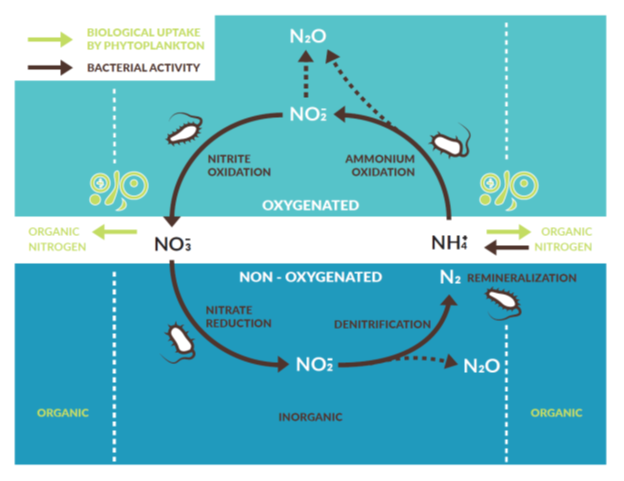Nitrogen Cycle
Background
Nitrogen is a major nutrient supporting the growth of phytoplankton, which are small algae responsible for the vast portion of carbon fixation and oxygen production in the ocean. However, a surplus of nitrogen can also cause eutrophication and harmful algae blooms. In addition to its quantity, the chemical speciation of nitrogen in seawater can also determine whether healthy phytoplankton growth or harmful overproduction occurs.
Therefore, the biogeochemical cycling of nitrogen is important, because it transforms nitrogen between bioavailable dissolved forms and unavailable gaseous forms. The process recycles organic nitrogen into inorganic nitrogen by oxidizing it. This oxidation, as one of the central processes of the nitrogen cycle, is called nitrification. It is a two-step process executed by two groups of microbes that collaborate to oxidize ammonium into nitrite (“ammonium oxidation“) and further oxidizes into nitrate (“nitrite oxidation“).
Bedford Basin is a nitrogen-rich coastal basin, where it is affected by wastewater from the Halifax Regional Municipality. An active nitrogen cycle exists in the dark bottom of the basin (60 m depth). In early summer, the bottom water becomes isolated from the surface water because the mixing of the water column stops during summer and fall. Ammonium begins to accumulate as a result of the breakdown of nitrogen-containing organic matter. Eventually, ammonium is then oxidized to nitrate by nitrification. By the time of the following winter months, a considerable part of the organic nitrogen would have been transformed into nitrate and stirred up to the surface as the mixing deepens. This nitrate can serve as fertilizer for the next phytoplankton growth period.

A schmetic diagram of the nitrogen cycle (Reprinted from Current Tides, Volume 3.)
A weekly time series to study the nitrogen cycle in the dark bottom water of the Bedford Basin
A project led by CERC.OCEAN PhD Candidate Sebastian Haas has observed these annual cycles of nitrification over several years, using detailed time series measurements. Every week, samples are taken from the Bedford Basin water column to analyze concentrations and the stable isotopic signature (δ15N) of ammonium, nitrite and nitrate as well as particulate organic nitrogen.
In collaboration with Prof. Julie LaRoche and Brent Robicheau (Dalhousie University, Biology Department), this geochemical data has been synthesized with microbiological data showing changes in the underlying microbial community that is responsible for nitrification. A further collaboration with Prof. Christopher Algar and Subhadeep Rakshit (Oceanography Department) has resulted in a biogeochemical model of the nitrogen cycle in the Bedford Basin bottom water. In combination with other oceanographic measurements, such as oxygen concentrations or salinity that reveal mixing patterns, this variety of approaches in the context of a detailed time series has revealed interesting differences in nitrification between annual cycles.
Two papers are currently being prepared for publication in which nitrite accumulations and delays in nitrification as well as associated stable isotope signatures observed in the Bedford Basin during several years will be presented and discussed.
Weekly Measurement for Nitrogen Cycle:
- Stable isotope composition of nitrate, nitrite, ammonium and particulate organic nitrogen (PON).
- Nutrient concentrations: ammonium, nitrite, nitrate, phosphate, silicate.
- Concentrations of N2O (by-product of nitrification) measured by gas-chromatography.
- Microbiological data (LaRoche lab): DNA samples for amoA qPCR, 16S rRNA gene sequencing.
- Oceanographic data (BIO, CEOTR): CTD, oxygen, nitrate sensor profiling.


